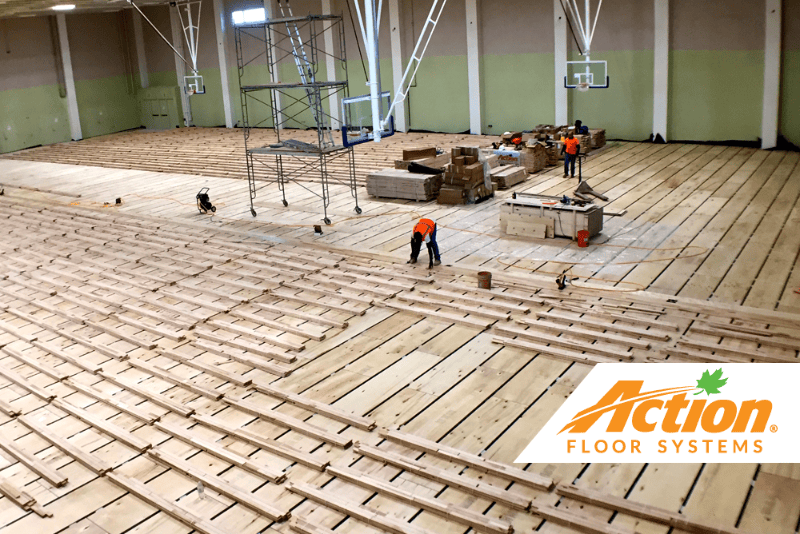
For most schools and athletic facilities, the gymnasium is the center of it all. It’s the place where athletes practice and compete, fans rally, and events are held. After years of abuse from camps and classes, games, increased traffic from tournaments, and general wear and tear, eventually, a maple sports floors will reach the end of its lifecycle and need to be replaced.
The decision to install just a new hardwood surface or fully replace the sports floor system is typically guided by budget restrictions and the condition of the floor boards and system underneath. By understanding the pros and cons of the various options to update your sports floor, you can make a responsible decision that meets your facility’s and the users’ needs.
We spoke with Action Floors’ Sales Representative Dave Fields to get some insider information on resurfacing with new flooring and replacing the complete sports floor system, why facility owners choose one over the other, and what to expect with each option. Fields has seen it all and shares points to consider.
Resurfacing a Sports Floor
Facilities will sometimes consider replacing just the maple surface of their sports floors when they have significant budget restraints, or the floor has been sanded to the nail heads.
Over the years, performance attributes and technology have evolved and been perfected. Systems that were installed decades ago were not engineered to provide the performance and safety features of today’s new generation of performance maple floor systems, which is why it’s important to understand what lies beneath the flooring surface.
Nonetheless, if the decision makers are adamant on just replacing the surface, a dealer will go to the facility for an on-site meeting. They’ll typically open the floor in a place that isn’t often seen, such as under the bleachers, to see the status of the system below.
“They inspect everything down to the concrete level to determine what system was installed and assess the condition of the existing subfloor system,” Fields says.
The dealer will be able to tell if there are concerns with the system such as rot, deterioration, warping, or other damage. If it’s an old system that is subpar compared to today’s performance standards the difference can be explained and discussed prior to proceeding.
“The problem is, by removing the existing maple and replacing it with new maple, you get back what you had,” explains Fields. “Meaning, the floor, at best, will have the same type of performance that it originally had. If there’s an athletic director or coach involved in the decision-making process, they’re going to want a floor with resilience to ensure it matches today’s standards for sports.”
Fields shares that there are two types of floor systems that were created back in the day that Action Floors recommends should always be replaced. Dealers are still finding them when they open up the floor.
“If it’s an old, antiquated wood sleeper system where the sleeper was pinned down to the concrete and it has 1x6s on a diagonal with maple on top, facilities will want to totally get away from that,” explains Fields. “There’s no resilience, which means, it’s just like playing on a concrete floor.”
The same goes for the old channel and clip systems. Neither of those systems has any resilience. “They were designed in the day for longevity and to handle humidity, but, again, are like playing on concrete,” says Fields.
When a sports floor doesn’t provide the proper shock absorption or deflection, an athlete’s joints and muscles may become sore or bruised. A quality sports floor is easier on the joints and muscles, and improves playability.
Additionally, if your sports floor has excessive dead spots, has nail heads showing through, or the boards are breaking at the end-joints, it’s likely that your floor system is in need of replacement.
Read about how the proper sports floor impacts athletic safety in a previous blog.
Replacing a Sports Floor
When a sports floor has reached the end of its lifecycle the majority of schools and facilities choose to replace the sports floor system. Replacing a sports floor means taking out both the maple and the subfloor system beneath.
However, before getting started on a replacement project, a sports floor contractor will need to know about the original system.
“It’s very typical that the facility owner isn’t aware of what type of system was originally installed,” explains Fields. “At that point, we recommend that one of our dealer partners opens the floor system to see what it consists of and evaluate the condition of the slab.”
This crucial step helps dealers understand the makeup of the original system, determine slab depression, and the possible new system options moving forward.
“Depending on what was there before, facility managers can replace with a like and kind system or can choose a system that offers improved athletic performance attributes,” shares Fields.
To guide facility managers in the right direction, Fields asks a handful of questions to guarantee the new flooring selection is a proper fit for the end users:
- What are the ages and athletic levels of the people using the sports floor?
- What are the primary and secondary uses for the space?
- Is the space designated for sports only or will other activities take place in the space?
Since an investment in a hardwood sports floor is also an investment in students and athletes, considering these questions from the get-go ensures the selection is a benefit for all.
Systems such as the Action ChannelFlex Ultra F or Action AnchorFlex have earned some of the highest overall performance test scores for evaluating attributes such as force reduction, vertical deformation, area indentation, and ball rebound.
Action Floors has other floor systems that adhere to performance standards, such as ASTM F2772, MFMA PUR Standards, EN-14904, and DIN 18032 Part 2 that offer similar performance, but with different variations depending on the facility’s needs. View the complete line of Action Floors’ maple sports floor systems for more information.
A trusted sports floor manufacturer can help you select the proper floor for the end users and should be able to provide test results proving performance and uniformity results.
Taking Action
Whether you plan to give your facility’s floor a facelift by resurfacing or are looking to reap all the aesthetic, performance, and safety benefits of a new floor system, choosing a sports floor partner that listens to your needs and requirements can make all the difference. Replacing a sports floor isn’t difficult when you work with a partner that prioritizes project management, athletic performance, quality materials, and creative floor design.
Check out some of our case studies and project profiles that showcase Action Floors’ approach to problem solving and our attention to detail and dedication, or check out our gallery of sports floor installations to learn more about previous work. If you’re ready to kick off your next project, contact us at 800-746-3512 or online to get started! We’ll do the heavy lifting for you.



















